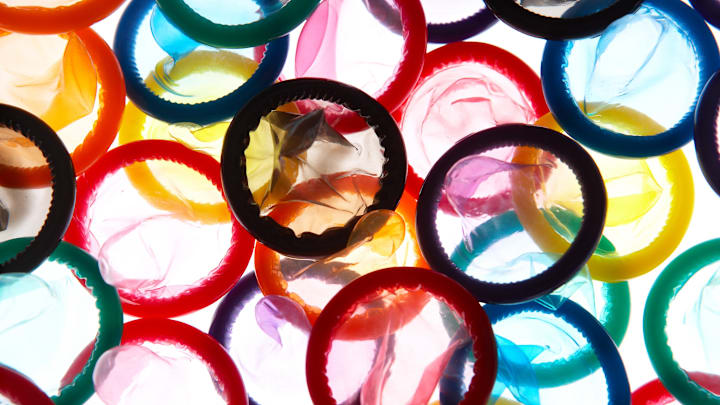The Olympic Village for the 2024 Summer Games in Paris is reportedly well-stocked with free condoms—about 300,000, to be exact. “It is very important that the conviviality here is something big,” Village director Laurent Michaud told Sky News.
That message is a stark pivot from the past two Olympic Games—Tokyo 2020 and Beijing 2022—when nasal swabs and social distancing replaced hugs and handshakes, and athletes had to leave the Olympic Village within 48 hours of finishing their events. Usually, they can all stay through the closing ceremonies, allowing them to partake in the rollicking party culture that has characterized the Village for decades.
But even as the COVID-19 pandemic quelled celebrations in close quarters and athletes were forbidden from any “unnecessary forms of physical contact,” one tradition didn’t change: free condoms. In Tokyo, they numbered around 160,000, and officials accommodated the mixed signals by simply telling everyone to take the condoms home with them as souvenirs.
They were meant, organizers explained, to raise awareness about HIV/AIDS—which, coincidentally, is also why the custom began back in 1988.
Sex Education
By the time Calgary, Alberta, Canada, was preparing to host the 1988 Winter Olympics, AIDS raged across the globe. Public health experts advised Olympic organizers to supply their athletes with free condoms, which were then stocked in the pharmacy at the Olympic Village. Sure, competitors had to ask for them, but there wasn’t exactly a culture of secrecy around sex during their stay: The on-campus store even carried porn magazines.
“We’re not running a Victorian temperance society here,” Olympic Village mayor Bob Niven told the Associated Press.

AIDS prevention plans were already in the works for the upcoming Summer Olympics, too, which would take place in Seoul, South Korea, that fall. After scrapping a proposal to test all the athletes for the disease, officials decided to supply the Village with 6000 or more condoms, along with pamphlets explaining the hazards of unsafe sex.
Later Olympic organizers upheld the precedent, varying the specifics and increasing the number of condoms with gusto. When Albertville, France, hosted the 1992 Winter Olympics, the 36,000 condoms distributed were free for athletes and roughly $2 a pack for other personnel; the condoms also matched the colors of the Olympic rings: blue, yellow, black, green, and red. At Barcelona’s Summer Olympics later that year, the condoms, which now numbered at least 60,000, were initially available to purchase from vending machines in the Village’s on-site discotheque. But according to one news report, athletes “complained they never had the right change,” so officials just handed them out for free.

Lillehammer, Norway’s 1994 Winter Olympics featured vending machines, too, some installed in an elementary school converted into temporary housing for volunteers. Though students were on break during the Games, class was still in session when the dispensers first appeared in the halls. “The machines came as a total surprise. In addition, there were notes saying that some of the condoms had a taste of raspberry, which the students here found extremely amusing,” one school principal told the press. He covered the dispensers with paper, which the students promptly tore off.
It was also in Lillehammer that news outlets reported an unholy flood of condoms cramming the sewage system, due to Olympians’ habit of flushing them down their toilets around the clock.
It Takes a Village

Since its inception, the free-condom custom has overtly aimed at curbing the transmission of HIV and encouraging safe sex. That didn’t necessarily change with the arrival of the 21st century, as AIDS is still a global crisis. But the success of highly active antiretroviral therapy (HAART) as a form of HIV treatment sparked hope in the late 1990s that those living with HIV could go on to lead long, healthy lives. So in the early aughts, the commercial marketing and publicity surrounding condoms at the Olympics began to be a little less about public health and much more about winking at the by then well-known amorous tendencies of Olympians.
At the 2000 Summer Games in Sydney, Australia, athletes were depleting the 50,000-strong condom cache so quickly that manufacturer Ansell shipped an additional 20,000 to the Village several days before the closing ceremony. “Judging by the demand the medal tally is certainly rising both in and out of the sporting arena,” an Ansell spokesperson said. He also revealed that products with “peppermint green studs” and “strawberry ribbing” were especially hot commodities, and that certain athletes had asked for larger sizes. Durex took over as supplier for the 2004 Athens Olympics, providing a staggering 130,000 condoms and 30,000 lubricant packets “to smooth the performance of the world’s elite sports people in the arena and under the covers,” according to a statement.

All the condom talk also gave rise to a number of cheeky and occasionally ill-conceived think pieces about everything from how sexual activity might impact athletic performance to which Olympians should couple up. One 2008 article even laid out a math problem asking readers to use stats—condom supply, number of athletes, length of Games—to determine how often Beijing’s Olympic planners had expected competitors to get physical.
The condom count hovered around 100,000 until 2016, when Rio de Janeiro broke all records by distributing 450,000 condoms, 100,000 of which were female condoms (a first in Olympic history). And while the details continue to vary from Games to Games, the reason for the giveaway is the same as it’s always been: Birds do it, bees do it, even world-class athletes performing near-superhuman feats do it—and since they’re going to do it, let’s make sure they do it safely.
Read More Stories About Olympics History:
A version of this story originally ran in 2022; it has been updated for 2024.
